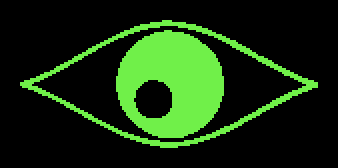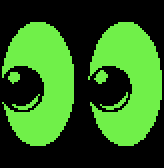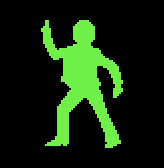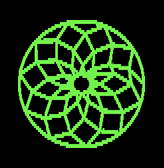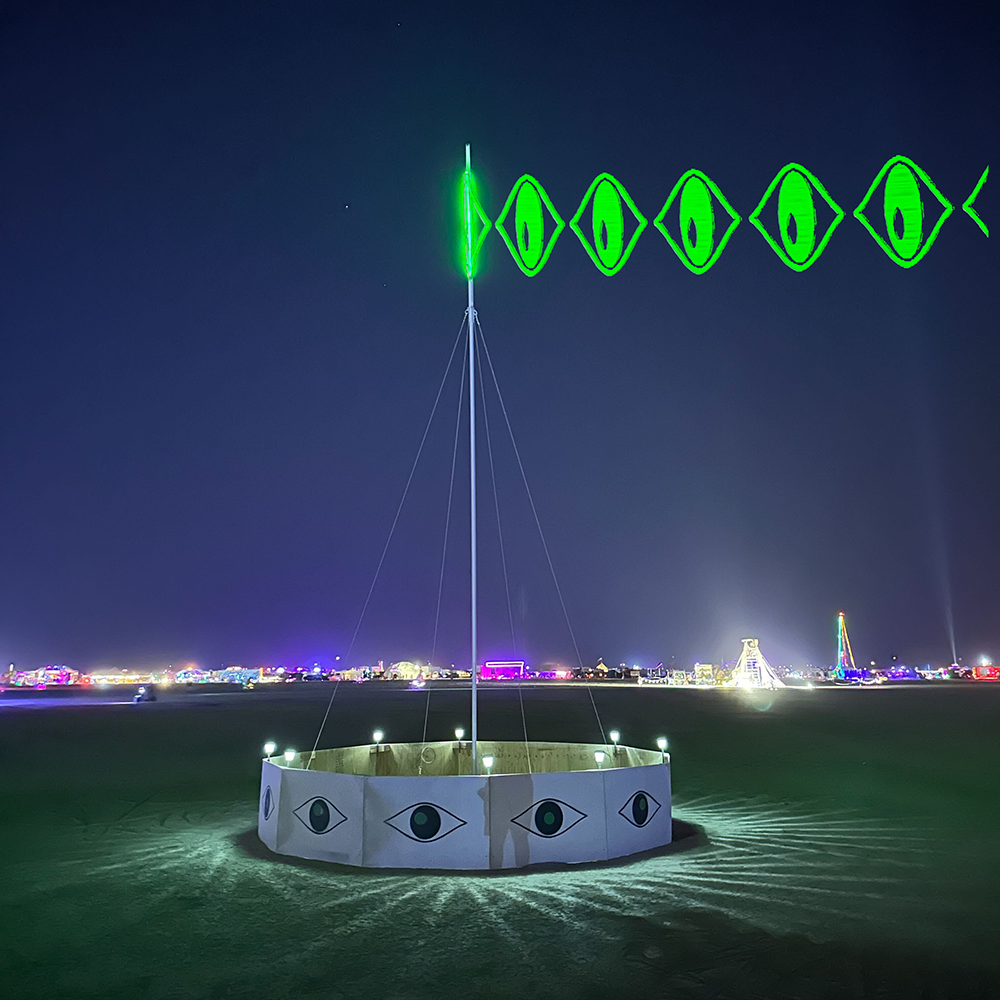
In 1980, around the time that I graduated from high school and entered college, Bill Bell, then in his early 50s, invented a new kind of LED display that he called a “Lightstick.” Obtaining a patent for his idea (newspaper article), Mr. Bell created and showed various Lightsticks in over 100 locations throughout the world. One of those locations is the Exploratorium in San Francisco.
Visit the Exploratorium today and you can find an updated version of Triple Aye, Mr. Bell’s Exploratorium Lightstick that originally was commissioned in 1983. Stare at it, and you see just a shimmering vertical line of LEDs. However, glance back and forth to the left and the right of the line, and Triple Aye will paint an image on your retinas. You must move your eyes to see the image. That’s the magic of Mr. Bell’s Lightstick invention. You don’t see the image until you look away!
I remember seeing Triple Aye at the Exploratorium in the 1980s. Below is a timed-exposure photograph from Mr. Bell’s web site showing how it looked then: as one moves one’s eyes, a yellow, vertical line becomes either the word “eye” or an image of an eye. Inspired by my four-decade-old memory of Triple Aye, I created Persistence for Burning Man 2023.
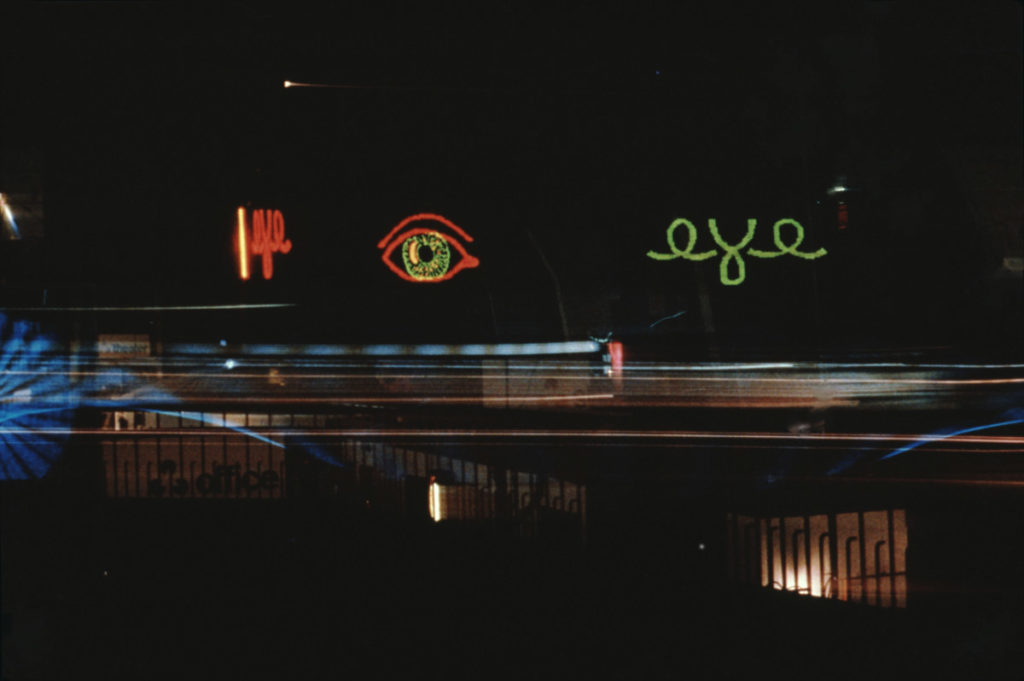
Origin of Lightsticks
Bill Bell first discovered the Lightstick effect by connecting a line of eight LEDs to a small digital memory that was driven by a digital binary counter (as shown below, a simplified version of Fig. 2 from his patent). The small memory stored successive columns of a matrix display of the word “HELLO.”
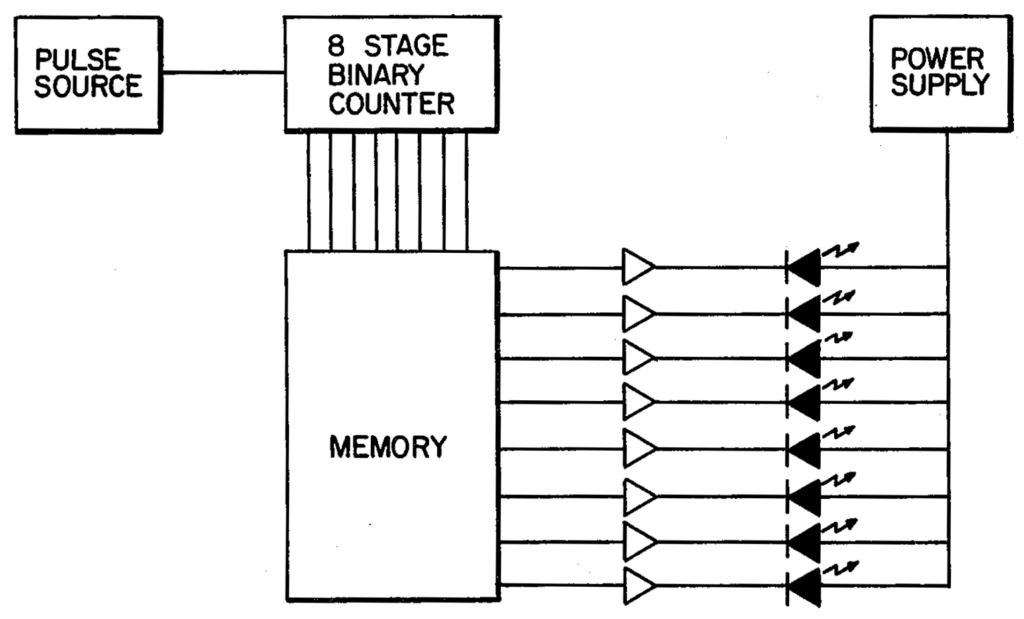
After Bill Bell set the LED display modulating, he then glanced back and forth between two items on either side of the display (the cup “B” and the inkwell “A” shown below, a simplified version of Fig. 4 from his patent). Although he expected that he would see the word HELLO, he reports that he was surprised that the word appeared positioned over the inkwell.
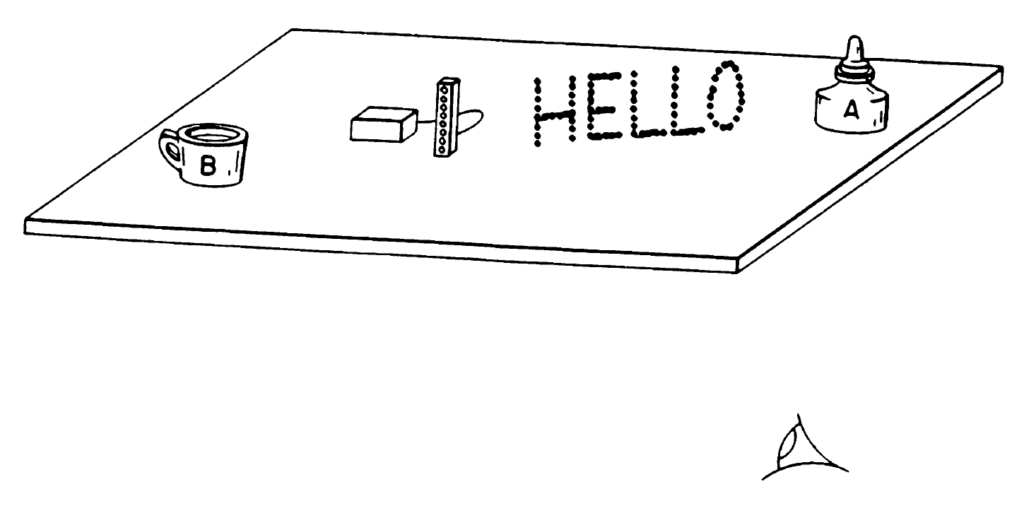
All of Bill Bell’s Lightstick displays show the same “saccadoscopic” effect (as he calls it) and are created similarly, by modulating a vertical line of LEDs. For more history on Mr. Bell’s Lightsticks and his other saccadoscopic displays, see his article in Leonardo.
My Lightsticks
Cheshire Cat (2005)
In 2005, I was invited to an Alice in Wonderland theme party. As part of preparing for the party, I created a small Lightstick with 28 red LEDs. Then at the party, after sunset, I placed the Lightstick in a tree and turned it on. Anyone shifting their eyes left and right while looking up in the tree would see the Cheshire Cat. That Lightstick showed a single grayscale static image (although colored red, since I had used red LEDs). Below is a recreation of what folks saw when they moved their eyes.

imagery in the 1951 film Alice In Wonderland by Walt Disney Studios.
Persistence (2023)
Persistence was created for Burning Man 2023. It was designed by Victoria Hollis and me with construction assistance from Sisi Song and Nidhi Rathi. In addition, Matt Newton, Rebecca Rashkin, and Gary Spann helped with installation and teardown. Jordan Layman runs Idea Fab Labs, where most of the construction was done.
The piece consists of a 64-inch long Lightstick with 64 pixels. Each pixel is created from five forward-facing green LEDs and five backward-facing green LEDs. The Lightstick is mounted atop a 22‑foot tall mast making it visible from 360° around the piece (see the photograph at the top of this page).
Timeline on the Playa
Saturday test (August 26, 2023): In camp I connected the controller and the Lightstick of Persistence to verify the controller’s programming. Confirming that everything worked as expected, I disassembled the parts and loaded them into the Highlander and onto a trailer for later installation on the playa.
Sunday, Monday installation: Victoria, Matt, and I installed Persistence on the playa.
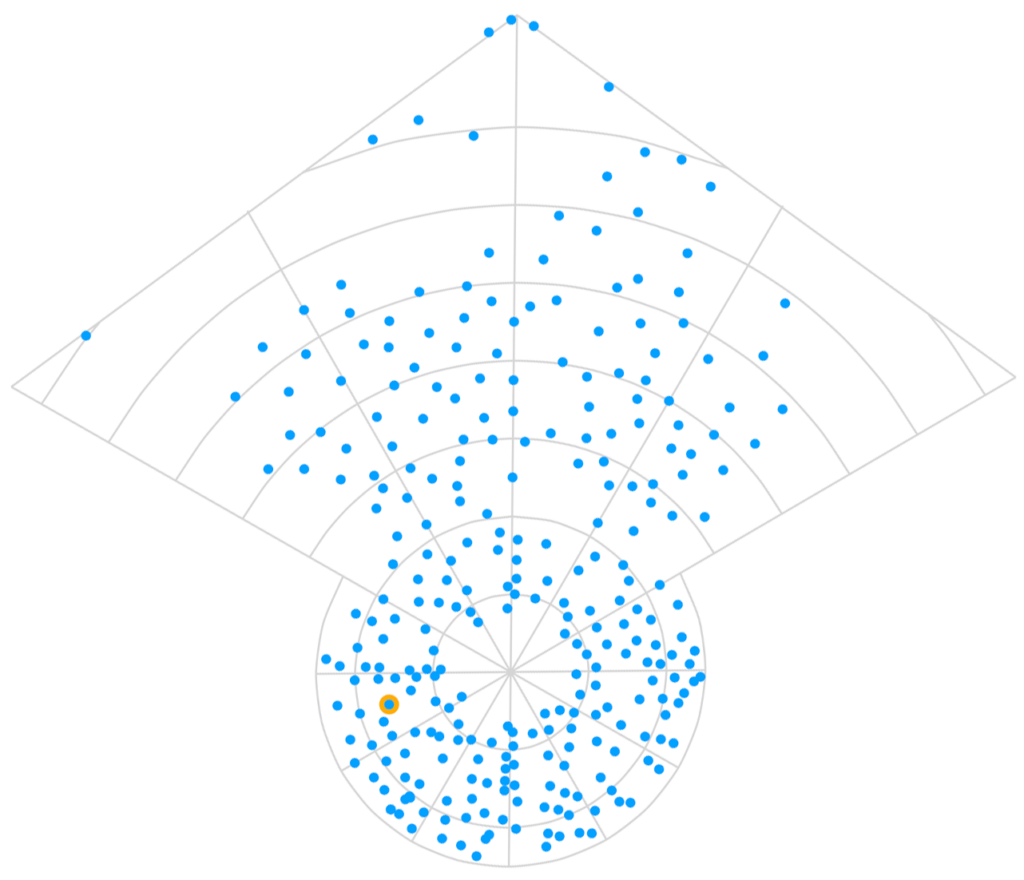
Monday evening initial power up: After sunset, when it was dark enough to properly view the Lightstick, I discovered that the piece was not operating correctly and illuminating only one pixel! Seeing no obvious cause, I spent the first part of Monday evening touring other art pieces with campmates.
Tuesday morning repair: Before sunrise, while it was still dark enough to view the Lightstick, I returned to Persistence to diagnose its problem. A careful audit revealed that I had plugged the Lightstick into the wrong data port of the controller! Merely moving the cable’s plug to the correct data port fixed the problem, and Persistence worked as intended!
At that point, morning arrived and the brightening sky washed out the Lightstick effect. So I returned to camp.
Tuesday night operation: That evening, as the sky darkened, the Lightstick effect of Persistence was visible again, and it cycled through a series of icons starting with Victoria’s “eye” image.
The sequence continued with a diamond, a club, a heart, two eyes, an arrow, and a dancing man, each alternating with the eye image. The asymmetric images appeared to flip as one glanced left and right.
Wednesday night operation: On Wednesday I ruminated over adding words to the sequence of images. That evening, while reprogramming the controller, I adjusted the list of icons and added the word “EXPLORE“.

Thursday night operation: On Thursday I switched the words to use a typewriter font. That evening’s reprogramming added “Discover”, “Glimpse”, and “Perceive”. There also was a Dreamcatcher.
Friday rain: We knew that the weather forecast predicted rain, and the expected rain arrived in the afternoon, making things very muddy. So that evening I stayed in camp.
Saturday, Sunday mud: Surroundings remained muddy, and I remained in camp.
Sunday evening: I walked to a nearby road intersection that had an unobstructed view of Persistence, which was about half a mile away. Normally at night it was possible to see the green Lightstick in the distance, but on Sunday the Lightstick no longer was illuminating. My original idea had been to reprogram Persistence on Monday for that evening’s Man burn, but after examining the controller (whose enclosure had let in rain and dust), I decided not to attempt repairs for just one extra night.
Monday, start teardown: On Monday it still seemed a bit too muddy for driving, and so Rebecca, Gary, and I walked out to Persistence, lowered the mast and Lightstick, and walked them back camp. What remained on the playa could be transported in the Highlander later without using the trailer.
Tuesday, finish teardown: Tuesday, with the playa sufficiently dry, Rebecca, Gary, and I drove out in the Highlander and brought the rest of Persistence back to camp.
Wednesday departure: The next morning, Wednesday, September 6, 2023, I finished packing and drove home.
Afterward
Creating Persistence took more time than expected, but assistance from those mentioned above ensured that it worked on playa. The original plan for Persistence included an interactive component whose creation and wiring was not complete by the time I needed to leave for Nevada. However, there is time before Burning Man 2024 to complete the intended work. So look for a new piece, Saccadia, in the desert next year.
References
Bell 1984: Lightstick patent. Bell, Bill. 1984. “Momentary visual image apparatus.” US Patent 4,470,044, filed May 15, 1981, and issued September 4, 1984.
Jones 1984: New York Times article about the patent. Jones, Stacy V. “Momentary Images from Light.” New York Times. September 8, 1984. Section 1, page 32.
Bell 1986: Leonardo journal article about Lightsticks. Bell, Bill and Theodore E. Parks and Robert B. Post. “Elusive Imagery of the Lightstick.” Leonardo Vol. 19, No. 1, 1986, pp. 3–10. The MIT Press.
